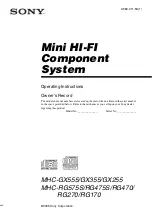
Audio Owner Manual
Section 4
REAR PANEL CONNECTORS
INPUT CHANNEL CONNECTIONS
Individual Phantom Power Switch
When selected, this switches the
D.C. phantom power for that channel
but only if the Master
switch is also selected on the front panel. Use this switch
only for condenser
that need powering. Avoid using phantom power on
dynamic or ribbon
A dynamic mic will usually be unaffected, but damage can
occur to some ribbons.
Mlc Input Connector
3 pin XLR connector used to connect balanced low (e.g. mic) level signals into
the channel. Pin 2 is hot, Pin 3 is low and Pin 1 is shield. Input impedance is approx
3k Ohm without pad, dropping to 2k Ohm with pad.
Line Input Jack
Balanced
stereo jack used to connect high (e.g. line) level signals into the
channel. This will accept balanced or unbalanced signals. Tip is hot, Ring is low and
Sleeve is shield. For unbalanced signals, use Tip for the input and tie Ring and
Sleeve to the shield (this happens automatically when you use a mono
jack
plug). Input impedance is 20k Ohm balanced, 1 Ok Ohm unbalanced.
Channel Insert Jack
Stereo Jack used to insert signal processing devices into the channel.
The Tip is used for the SEND, and the Ring connection is used for the RETURN.
The insert point is located after the preamp (either Mic or Line input) and before the
EQ section. Nominal signal level is
output impedance is 50 Ohm, return
impedance is
Ohm. This jack can also be used as a borrow jack ; insert a
stereo plug with Tip and Ring tied together to access the preamp output without
affecting the channel signal. Useful if you need a Pre-everything feed and all the
Auxes are tied up
Channel Direct Out
This unbalanced output is normally the Post-fader, Post-mute channel signal.
Internal jumper links allow you to change this point to Pre-fader or Post-fader,
mute (See USER CONFIGURED OPTIONS Section). Output impedance is 50 Ohm.
The recommended load is 2k Ohm or greater; Nominal level is
Use this jack
if an isolated signal is needed. By using the Post-fade/Pre-mute position and muting
the channel to the Scepter
mix, each direct out can be treated as a 1 input
mixer; the controls will function as indicated, but the signal will only be present at
the Direct Out jack.
24














































